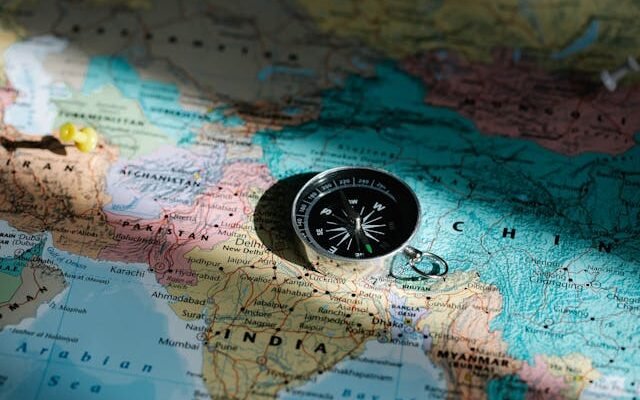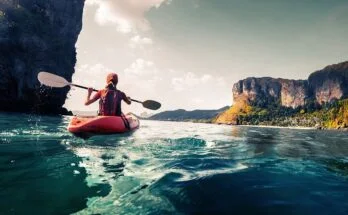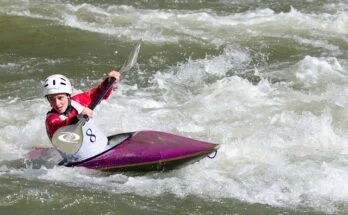We reside in an era where satellite tracking is a daily occurrence. The latest and advanced Compass For Kayak GPS navigation systems have now reached such a sophistication level and are now common that anyone would wonder why anyone would use an old-fashioned compass for kayak.
But here’s the ugly truth:
These high-tech gadgets are without a doubt very helpful tools, but they are far from infallible. They can stop working, interfere with each other, run out of batteries, and have weak signals.
It is amazing witness to how important this skills is than to be paddling for twenty minutes in a foggy whiteout having the wind in your ears as well as peach hair standing on your neck
Out of being detailed, navigation from A to B is it. But as a well navigators, the experience is more empowering for we will understand our planet better and explore the same more safely.
With it short, GPS technology of the modern day might and certainly is going to stumble.
And when it happens, there is nothing as useful as a compass for kayak to help you trust your instincts and to get back on the water your compass for kayak is the tool in this because it helps you find your way out in the water.
Here is a list of things you must have in your mind before buying a compass for kayak !
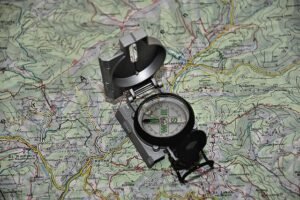
How We Tested & Rated Our Top Picks
we don’t treat testing as just a trivial thing, as it’s something that affects our safety on the water significantly. We evaluate products related to the trade-off of conditioning they must be exposed to as a kayaker. Here is an overview of our compass for kayak selection and evaluation process:
1. How We Selected
Our initial selection featured over two dozen compasses resulting from the determination of the most popular ones via surveys, research, and peer consultations.
Finally, out of numerous options we ignored, we were able to identify which models have the best features, are of better value, and are available almost everywhere.
In addition, the unsung heroes or the standout choices were appended to the list to make sure that every kayaker had a reliable compass For Kayak for every situation.
2. How We Tested
Each product on the list was subjected to a long sequence of tests that simulated a vast range of scenarios the kayakers might encounter when they use their compass for kayak to navigate in the water.
One more thing to highlight here is that we were a customer themselves and we bought every product that we tested by ourselves instead of doing it by suppliers or manufacturers.
Here are the criteria we used to rate the compass featured in this round-up:
- Durability – We have paid attention to the materials used and subjected them to touch with cool water, cracked ice, and direct sunlight to see how they appear after impact.
- Visibility and readability – Different sensors in different lighting conditions such as sunlight-light to complete darkness were tested.
- Accuracy: We carried kayaks to several regions and compared the results obtained from chip-compensated compasses with those from GPS and traditional maps.
- Value for Money –The final full value for money score is collected which is based on a sum of the features, build quality, prices, as well as pricing comparison with similar products.
Employing our personnel recreation kayaks, we conducted a thorough trial course of the items to assess their performance. This testing was really extensive – it lasted 14 hours and involved several tests – a river, sea, and cloudy/clear weather – in one place.
3. How We Rated
The product was rated on a 1-10 scale for each tested criterion as was every other product. The scale is defined as follows:
- 1 (Lowest Rating): It refers to the fact that the compass was not functioning and looked quite out of date for the usual standard used for an instrument to be considered “usable”.
- 10 (Highest Rating): Implies that the compass passes or even meets the requirements of performance and demands of quality expected by the users.
This rating system allows us to be precise with the kayak compass assessment, applying comprehensive and differentiated rating criteria.
This allows our readers to gain a profound knowledge of the pros and cons that each product pretends primarily to alleviate. The main aim of use is to not only have them provide information but also make it easy for readers to understand and base their decisions on.
1. Brunton Dash Mount Compass 70P
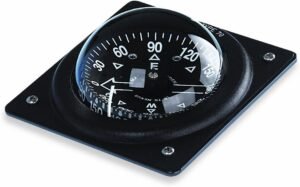
From the second the Brunton Compass was mounted to the kayak, I knew it would be an unbeatable feature for all my touring trips.
I have started off with a lot of different compasses, and after using them for all these years, the Brunton 70P immediately hit me as the most robustly built inned, highly accurate, and easy to use – the features that are absolutely mandatory for every passionate kayaker to have in a compass.
Deepy-heavy-duty appearance is not only shown, 70P’s design also serves heavy use. In the course of a telecompass trial around the south coast of England, among strong and irregular winds with rapid weather changes and variable visibility, this telecompass got all my respect.
Even as the ocean salt spray, rain, and the waves would apart it, it continued to meet my expectations, faultlessly sensing the bearings even when exposed to such conditions.
The 70P is also equipped with a 16-inch dual disc fuse and a bimetal thermometer with a large attractive temperature-sensitive disc. The remarkable truth is that,
Despite the fact that my friend and I were navigating in choppy waters, I had an almost perfect understanding of my direction and was able to map my readings very precisely.
Unlike other compasses that are slow to get into position and require a pause, 70P is able to show direction immediately. Needless to say the one that has contributed to how I’m now doing better in terms of staying focused is this feature.
According to the direction-finding properties of the compass noteworthy is the feature of visibility under changing lighting conditions.
It doesn’t come with the coolness of glow-in-the-dark dials or night-vision lighting, but it sure does give me readability on bright sunny days., It is here because of the well-executed dial and distinct symbol markings.
The 70P dial is so bright and clear, even in some cloudy or hazy days when visibility is not keeping the top level, you will still have a great view through it without any problems.
Mounting was a piece of cake, and upon being influenced by a few friends that had the part before I went ahead and spent a few extra dollars in getting better quality screws instead of the original ones that came with it.
Hey, don’t get me wrong! I’ll tackle the elephant right away; which is price!
Whatever way you look at it, 70p is definitely not on the lower end of the price spectrum. But, although is more expensive than majority of compasses on the list, the quality return on investment worth consideration priced it on high. I would never just go plainly call it ‘overpriced’, lowest quality preventing you to stay with it longer than your kayak!
Technical Specs
- Type: Deck-mount compass
- Size: 4 x 3 x 3 inches
- Weight: 8.3 ounces
- Dial: Size not specified
Brunton 7O p is a worthy contender for kayakers who are dead set on having a dependable device that features high precision and clarity to accurately measure the depth and get the most out of their trips.
The Ritchie V-527 Bulkhead mount is definitely one of those cheaper option, there isn’t any model I knew that can give 70p all-around performance.
It’s a compass that has all the features you will find in a kayak friendly device and this makes it a true outdoor tool. This goes to all of those who are really into the paddle adventures; this will make a good read for you.
2. Kayaker by Ritchie Navigation XP-99
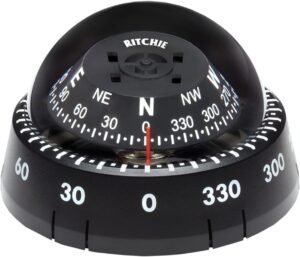
As far as specifications go, the Kayaker by Ritchie Navigation XP-99 has been dubbed “Most Versatile Compass”, but that does not stop me from recommending it as a one-size-fits-all navigation device given its proven ability to face my noticeable range of kayaking obstacles.
Its mixture of hardness properties, extendability and precision, all that are slights more affordable that the chosen top model, makes it a remarkable product for the kayakers.
This compass for kayak is resilient, and it promises durability beyond its usability. Visualise yourself in the position of xp-99’s Compass as it can withstand the gruelling Hell Week of Commander Charli, the NASA emergency commander, and be sure that you have got yourself the xp-99.
A series of test situations were designed to include water sprays, direct sun, accidental hits using on the paddle and a drop on the ground. Every time I watch it win,
it feels like it takes me from start to finish, right back to the beginning, just ready for more. The space structure has already delivered us something more than we could imagine. It has a nudge towards survival as it is combined construction, which is intended to be durable.
With the inner diaphragm, which is built in the compass to maintain its operation at cooling and high intensities, it successfully displayed itself in the long cold mornings and hot afternoon paddles while remaining clear and accurate without a face-up water vapour forming.
This was further aided by the 2.75-inch direct-reading dial. The large markings make it easy to navigate quickly with just a glance. I found the adjustable bezel with its memory indicator especially helpful in keeping track of my starting course.
While the lack of built-in illumination for low-light conditions is a drawback, the optional light kit (extra cost), which runs on 12V batteries, is a solid workaround for early morning or late evening paddles. It’s a bit of a letdown that it’s not included as standard, but the kit does its job well, and I guess it was a choice to keep the cost down.
At a 12 oz weight and 7 inch widest size, the XP-99 isn’t the smallest and lightest of all. Every space has its restrictions. It will not be feasible if are short of space, or you’re a minimalist. Specs outweigh is going to put you off more popular smartwatches –not for me however.
The detail that clearly defines XP-99 stands with regard to mounting options being very convenient. The mounting approaches, i.e. tie-downs (K-TD.2 type) and screw-in, were put to the test. The rack is absolutely perfect for those who require zero commitment and have few kayaks per household.
At the same time, the rack promises secure locking in all conditions. As compared to the toggle method, screw-in technique while asking for sometimes more time and creativity to be spent on solutions for non-flat yak decks, guarantees an unsurpassed stability.
However, just as with any product, it does not come with a fixing kit and it’s just a little shortcoming that would entail a short trip to the local hardware store – luckily, Richie’s mounting diagrams are very helpful.
Technical Specs
- Type: Surface-mount compass
- Size: 6.9 x 6.2 x 7 inches
- Weight: 12 ounces
- Dial: 2.75-inch dial
Instead of the Brunton 70p which might be too expensive, the Kayaker XP-99 is an economical and premium free alternative. The compass featuring here is an outstanding one, for it doesn’t only carry out the task, but it also outperforms and delivers more, including, versatility, ruggedness, and sturdiness just to mention a few.
These are just the small size of the machine and the epillumination when a person goes into cave in darkness and that is rather negligible comparing to the value it adds to us. Kayakers whose pursuit of top navigational aid within a particular budget will definitely find the XP-99 as the supreme one.
3. Silva 58 Kayak Compass
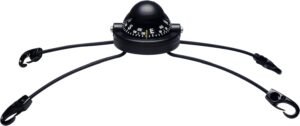
Silva’s navigation credibility is beyond question, since the company was the first to invent the liquid-filled compass back in 1933, they will remain the pioneers within the compass design and technology sphere. That’s easily understandable if you remind yourself that they are the people who originally designed the trusty device which helped plenty of people find their way.
The superbness of the Ås Silva 58 is not up for debate, in this case in accord with its roots. It’s a good, no-nonsense compass that’s just designs for those kaykers, which is for a kind of people who just needs something steady, and easy to work with.
Typically so, this kind of paddle is meant for practicality purposes and would conveniently serve those who lack a compass mount or those who switch paddles frequently. From one V to the other, the compass verily slipped effortlessly and swiftly like the round and the slippery pea in a famous childhood game.
The durable ABS plastic case with rubber tie-down straps which I connected provided the tenseness, absolutely not giving in to any swinging in the water. While I was hitting the worst of the rapids on a river section, tossed and shaken, and my boat creaked and leaked, everything on and in the Silva 58 stayed in place and kept me safe.
This issue is also associated with the Silva 58 which is one of the strongest point. The compass has it large NESW markings and little degree minimasonal that cases are super supportfully when steering through waters that are not well familiarized. I observed that I was easily spotting relevant information on the compass without the need to concentrate on it.
Nevertheless, I have noticed a small but important lag when it comes to the compass’s readouts during rapid turning manoeuvres. It is a trivial issue that doesn’t cause serious problems to compass productivity in entirety, but one might pay attention to this effect if it draws attention to your habit of instant feedback.
Thankfully, there is no perfect product out there. But, at the same time, a lot of products do have some drawbacks. One drawback for me was the kind of night I did not have a sense of sight. As far as say, a dusk paddle is concerned, a lack of a pre-installed flashlight or the possibility extra one is to be equipped with the compass is a depressing outlet.
Eventually, I was forced to use the glowsticks for the outside, and while these were certainly a savior to the situation, I couldn’t help but feel that they were only bringing me half-way through instead of fixing the actual problem.
Technical Specs
- Type: Tie-down compass
- Size: 6.5 x 2.76 x 6.3 inches
- Weight: 4 ounces
- Dial: 2.1 inch dial
The Silva 58 Kayak compass is unbeatable if you are kayaking and bow units should be minimized while stability and functionality must be put into consideration.
That is why its mount system that attaches to SUP boards quickly without compromising its durability in different environments is a brilliant choice for many paddlers. This unit can be used by both recreational paddlers and some seasoned adventurers.
Although it is not very bright for night time reading, at midday, any imperfections in its performance are quickly erased, and because of this, it is an optimal tool for any kayak tour.
4. Sun Company Seaturtl Kayak Compass
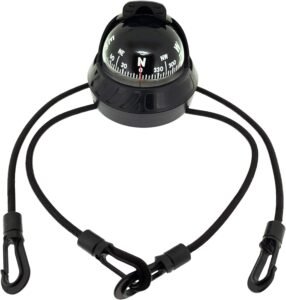
The Sun Company Seaturtl gains popularity among watersports enthusiasts because of its strong and fussy construction which is specifically created for kayaking, e.g.
Nevertheless, this is a thing that has got attention and polarized our team in WaterSportsWhiz, producing different points of views.
Some team members have acknowledged those things that have acted as catalyst for the growth of the company. However, there are those who have identified where it lacks and may not fulfill the needs of selected members of those targeted by the company.
Our review did not, unfortunately , started that day well. After removing our SeaTurl from the box, we realized that the alignment of the din indicative line was not right (the index line was at least 3 degrees skewed).
Such issue might seem insignificant; still, even a minor deviation from the dead center can cause an error later on while making the directional correction. By the way of continual, we got reliable service and fortunately the new bulb went in, without any refusal by Sun.
The essence of this compass is toughness, a feature that is bragged about by this team. In matters of durability we have nothing to say but praises. Its soft-rubber casing features a dial filled with liquid that makes it a master in facing the harsh elements of kayaking trips on the open water – at least for my requirements.
We made it perform in almost any type of sea conditions, even requiring it to do more than its duty, and we found that it not only succeeded but it way beyond what we expected.
The SeaTurtl proved to be such a stable and dependable platform that even when the waves drew the kayak this way and that way, it stayed clear and readable without making the paddler go dizzy.
It was very impressive for us that the hood was a part of the stove. It’s like the lenses for polarised sunglasses; the luminous sun hinders your view through the windows much less, so in that way it’s easier to use even small devices to navigate.
Additionally, it does not only shield the light whenever you’re kayaking, it also protects the lens from getting scratches when you’re not using it. We did not have to move forward to the front while the full size dial with large and clear markings ensured its reading would be fine even from the very back of the cockpit were the compass was mounted.
Even with these advantages it has been debated that SeaTurtl’s album in low-light rooms puzzled our team. The white marks on the dial that should be legible under any circumstances start to be lost from view as lighting disappears in the increasing darkness or that of an overcast atmosphere.
During a single testy evening paddling session it struck me that an led light was the only way to complete the readings and the group discussed if it could really be trustworthy for dawn or dusk paddles.
We would be very surprised if Sun Company has not already thought about having a watch like these, and we are sure that it will go well with the addition of a built-in LED lighting or painting the dial marking with iridescent color.
However, that is not the case – the compass attaches on 4 adjustable elastic cords that clip to your deck lines for an easy and of course holes-free installations – all through time.
The compass for kayak is held firmly in place as it attaches to the cords. Plus, if you are like me and also own more than one kayak, you’ll be extremely pleased by the fact that it is perfect for your flat and curved hulls. That goes for your paddleboard too, should you be one of those lucky few who own one.
Technical Specs
- Type: Full-size marine compass
- Size: 4.1 x 4.1 x 2.9 inches
- Weight: 8.8 ounces
- Dial: Dial size not specified
A SeaTurtl Compass for kayak by Sun Company can be a great purchase option if you are looking for a compact but sturdy compass that has great readability and can work with various types of mapping software. Even though it is not suitable for many who frequently kayak at night, nevertheless, this life vest will provide an outstanding value for the money.
5. Ritchie Navigation X-11Y
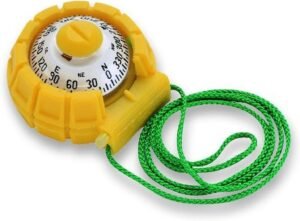
Those with the budget may be attracted to the simple but a justifiable option for price-conscious beginners and those who need alternative options. It’s light and very user friendly for my intended purpose, nothing fancy, just a basic idea.
I’ve carried it for more than a year, and it looks way more resilient and sturdy than I thought it to be at this modest price range. The feature that I am most concerned about when reviewing the budget minded gear is the durability.
Surprisingly the X-11Y had no problems on the testing. It may be small and light ,. But however, this small device is tough enough to deal with the knocks and problematic that kayaking usage will normally throw at it.
A 2-inch-diameter dial is enclosed by an extensively visible silicone-rubber cylindrical housing. All in all this design is really practical and long-lasting while still being able to withstand the typical spills and knocks. Not unbreakable, of course, but it’s could even survive a trip for the everyday use of a kayak.
The second sentence from the article “When Climate Change Threatens Us All” states, “Half the world’s population lives in areas that experience high levels of air pollution.” This sentence aims to highlight the fact that a significant proportion of the global population resides in areas affected by high levels
The X-11Y has been my companion in the process of achieving my goal. I feel confident that it can be used for staying on course. The dial is somewhat untidy, nevertheless, following a while of accustoming to it, it is not a trouble.
Also the compass has a built-in roller diaphragm that can synchronize the compass with temperature changes so it works well for all those kayakers who prefer the watery season.
The headlamp has glow sticks attached to it, what is a cool invention for when it’s getting dusky. They do not complete the deal, but they do the job just fine and this has been proven over a period of about 3-4 hours.
Surprisingly, there are very cheap generic ones available that are just as effective (at least for me) and I’m paying half the price now.
As on the matter of X-11Y mounting, you can wear it, deck mount it, or tie it down – this depends on your owner-preferences with the opportunities were there. Plus, it is fun and simple to assemble, to be in any way that you favour your kayak’s seating and your own needs.
But let’s bear in mind that it will be difficult to take proper reading off the bearing needle of the orienteering compass swinging on lanyard while canoeing.
Installing the X-11Y is a quick and easy to perform. The product can be carried along anywhere. It can be hung from the neck or deck mount. It can be attached to the radiator or the car roof.
It has multiple ways to install on the deck. For this reason, it is perfectly designed to be an improvised and conforming equipment for all kayak models and style.
However, bear in mind that an orienteering compass from lanyard may not be appropriate when to take reading because the paddling may be difficult.
Ritchie’s assurance of 5-year warranty puts me in good faith. A guarantee like this is a symbol of how they believe in the compass being long lasting and of good quality.
A budget can often lack these supportive features which is why a reliable compass is recognized as an important flaw remedied by this compass.
Technical Specs
- Type: Handheld / deck-mounted compass
- Size: 2 x 5 x 7 inches
- Weight: 4 ounces
- Dial: 2-inch dial
The X-11Y does away with any extraneous features and achieves great value. It may not be fancy, but it is reliable, which is a great characteristic when you’re out in the center of the water. It doesn’t matter whether it’s your primary compass or a backup one you can rely on — the product won’t let you down.
6. Ritchie RA-93 Kayak Angler Compass
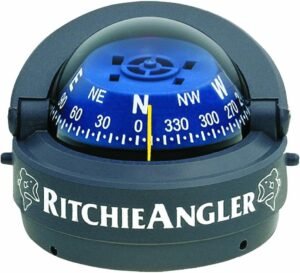
Let us proceed with another compass – this one is also from Richard, but he gives me somewhat different clue. RA-93 Angler Marine Compass is probably one of the most recognized navigational aid for fishing kayak in the open sea such as the Pacific Ocean or the Atlantic Ocean.
Having this compass always on your side makes travel to and fro the paradise of the reservoir a cake walk, although it comes with a price tag.
However, it goes very light on the pocket than the Burton one-mount compass and it does almost a same task. There was a dozen of hits per our test, and would result in a paddle or an end of a fishing rod to be considered as a whacker. No tracks were there after it disappeared.
The RA-93 model has a dial that is direct-read by 2.75 inches while it also graced with a gray finish already. The other solar panel component is its revolving sun shield, which is itself solar-powered and has green LEDs for visibility during the night. For certain, I’m more of the plug-in lights because it’s quite convenient to change a battery than having to change glow sticks or the ones used by the Luminator pads other of Richie compasses.
This feature is calibrated to the needs of a reader thus optimizing the brightness and contrast for comfortable reading whether it’s in bright sunlight or low light.
Besides an incredible readability, the RA-93 also has usability as a whole, starting with a built-in correcting system (see deviation adjustments) for compensation.
It senses the deck and installs directly, but there is a convenient push button release lever for detaching the compass when you need it. Such a storage option is great for the kayak when you just stow it away or safely put the compass behind it to steal it from thieves.
Regretfully,it is up to you to settle how it is to be attached. From the sentence: This needs to be done with a balance of high construction quality, aesthetic appeal, and cost effectiveness.
The K-TD.2 mount is our preferred choice for anyone looking at getting into astrophotography on a budget, as it is inexpensive and of great quality, and can also be used to view the sky if desired. But you can use other materials, like tape or Velcro, to mount it to the top of the globe equally well.
Technical Specs
- Type: Surface-mount compass
- Size: 6 x 6 x 6 inches
- Weight: 6.4 ounces
- Dial: 2.75-inch dial
The Ritchie RA-93 Angler Compass for kayak make a perfect choice for kayak fishing since they are a top-notch solution. With its excellent structure, durability, legible typeface, and bright backlight reading and appearing of funny pictures are not a problem in the sunny time.
At first glance a price point, there is certainly good reason to spend more on this product. But if you want to spend a little more at the higher-end of the price range but get a marine compass with selective features the RA-93 certainly is the right choice for you.
Compass For Kayak Buying Guide: Things To Look For & Features To Consider

The best compass for kayak of all is the one that does very well in terms of accuracy, legend, is rugged, and simple to mount or remove, all of which is required to catch you quota of fish easily. Presented are the main characteristics you should search for, given that you choose a headshot photographer yourself.
Durability
It’s much like any other kayak accessory in terms of how the compass should bear up against everything that occurs during kayaking – that being what the kayaking – and the nature itself would put you through.
This literally was hiking with a rock tied to my leg, and I think you will agree that there was absolutely no way to become scatheless in these conditions.
It should stay afloat in severe seas for years without any cracks or air leaks or barely indicative of long trip on the open waters. A water resistant rating of -06 (ideally associated with IPX7) and a plastic or a metal that is marine safe must be in your list.
You better to mind the internal portion of the dome, as a rule isopar, an ethanol mix, is used; it should be bubble-less and perfectly clear at all time. As Ritchie says, Isopar L is a type of liquid or fluid. It must be noted that the liquid must not grow to ice even under very low temperatures.
Readability – Easy to Read
Being capable of getting acquaint with your kayak compass for the right directions promptly is a major thing while navigating or keeping a steady position of your vessel. You wish to see that in a glance while you assume your kayak’s sit that’s ergonomically designed for you.
What good is it if you can’t see what it says?
As a big sized dial is crucial, you should select the compass with at least 2 inches diameter with clear marking. Also, luminous or self-luminous dials, where applicable, are designed to light up the display for night paddling and optimal low light visibility. Did talk about the good 4 hour runtime of these, you should be pleasantly surprised during most evening trips.
Check the area for unevenness and tilt, or it can affect your view. In terms of angle and location, verify with your vision line from the back of the cycle. Needing twisting or to lean down to read the flush deck seems like a smooth and troublesome thing but in term of utilization it kind of resemble endless banter. Make viewing distances and viewing angles a part of an evaluation of readability.
Mounting Options
Mounting a compass on a kayak you can either get a detachable or fixed mounting – and end up using the mount that you find more convenient.
Here are the two most common compass mounting styles:
- Tie-Downs –The other type of a compass for kayak fixing using bungee cords makes attaching and undoing easier as one can do it on the go. It’s not as rigid and immune to sudden hacks but it will CC: Its very strong and stiff nature, however, is the main target for people trying to break in.
- Deck & bulkhead Mount – a type of installation that is done with the use of screws above the deck, in a compartment, or through brackets. Only in case of the mounting being permanent bracket, one is left no choice but accept the permanent position of the compass. If you’re getting a separate mount, don’t forget to check if this mount is of a kind that can be placed on the deck with a curvature of +/- 24 degrees. This will cover the majority of the kayaks that I’ve been doing research on.
Declination Adjustment
An adjustment of declination is a functionality, which makes any compass used in navigation to orientate to the most appropriate direction, namely,
Magnetic north (the direction that the needle is pointing due to the earth’s magnetic field) and true north (the actual direction which is towards the North Pole). Be sure that the compass model you are going to buy has an option of magnetic declination adjustment within +/-20 degree range before using it for your magnetic declination measurement.
Two compass roses are shown on the maritime maps, whose outer refers to the true north and the inner one to the magnetic north. While geographic north and magnetic north are almost always separated by 500 kilometers, this alteration is insufficient to make a crucial difference in everyday actions.
Therefore, even though you won’t always need to correct your marine compass, when pursuing aeroplane navigation charts, still it’s a convenient asset.
Accuracy and Reliability
Having a kayak compass that follows your turns will not be useful at all if it fails to provide your accurate directions. In order to keep succeed in navigating, I look for kayak compasses with high accuracy and with calibration which is on the world base as I can use it on both hemispheres.
It’s normal for a compass to vary a little bit, especially if conditions vary. However, a good compass will still point towards magnetic north within a few degrees. Although booking a flight with deviation correction may temporarily inconvenience a traveler, consider models of at least +/- 40 degrees of deviation that ensure interference-free navigation.
Find out whether the compass is fitted with a back-up feature that keeps it alive amidst disturbance from a magnetic field.
Size and Weight
The best way is if a kayak’s compass is the size of around 3- x 3- x 2-inch for the deck-mounted models ( the wise weight is between 100 and 300 grams) and its weight is about 300 grams ( the ideal weight is between 100 and 300) Lighter models are a feature of low end equipment. Skip the load and size part but include the topic size.
Brand and Warranty
When dealing with brands and warranties, it’s worth to confide in well-known and proved brands like Ritchie, Brunton, and Silva. It is always a good idea to refer to reviews and summaries to see what comes out and alert you what you are subscribing to.
The period of the warranty 2 years is a necessary minimum – if shorter, beware. In the end, this process of elimination between brands and models can be a good filtration system to come up with a small list of the most likely matches for the chosen profile.
Price vs. Quality
Getting from a trusting company can sometimes mean a higher price. However, whatever kayak compass you choose quality has always been a crucial factor when buying expensive kayak compasses.
So don’t have any regrets in spending extra money (between $50-$100 for example) on finding a good, proven compass with extra features, being sure in reliability. The entry-level models start from $20, therefore our budget relevant to kayak supplies needs to be $20 too.
Best Compass For Kayak : Conclusion
An efficient compass is an inevitable administrable equipment for kayak navigation after all the options have been examined. The best quality feature that can appeal to varieties of paddlers is the specific voltage and its mounting style but all the products offered have high accuracy and reliability required to keep direction when outside on the water.
If that’s the case, which one’s the best kayak compass, then?
Well, my vote goes to the Brunton Dash Mount Kayak Compass.
It’s rugged and dependable, boasts a high degree of accuracy, and has a direct-reading dial that makes it easy to see – even in challenging conditions and rough water. Plus, most expedition kayaks already come with a manufacturer-ready recess made with this exact compass in mind!
Remember, though:
Your choice comes down to your preferences, your kayak’s design, and the mounting style that works for you.

